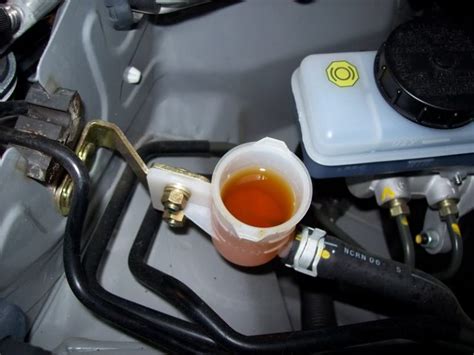How to Bleed Your Master Clutch Cylinder Safely
A properly functioning clutch is crucial for smooth and safe driving, especially in manual transmission vehicles. The master clutch cylinder is a key component in this system, and if it develops air bubbles, your clutch pedal may feel spongy, hard, or even fail completely. Bleeding the master clutch cylinder removes these air bubbles, restoring proper clutch function. While this task might seem daunting, with the right tools and a methodical approach, you can bleed your master clutch cylinder safely and effectively.
Why Bleed Your Master Clutch Cylinder?
Before diving into the how-to, let's understand why bleeding is necessary. Air in the hydraulic clutch system prevents the transmission of full hydraulic pressure to the slave cylinder. This results in:
- Spongy Clutch Pedal: The pedal feels soft and unresponsive, requiring more force to engage the clutch.
- Hard Clutch Pedal: In some cases, air can cause the pedal to become extremely stiff and difficult to depress.
- Clutch Slippage: The clutch may slip, resulting in difficulty shifting gears or a lack of power transfer to the wheels.
- Clutch Failure: In severe cases, a significant amount of air can render the clutch completely inoperable.
These issues can be incredibly dangerous, especially while driving. Therefore, addressing a suspected airlock promptly is critical for both safety and vehicle longevity.
Tools You'll Need
Before you begin, gather the necessary tools to ensure a smooth and efficient bleeding process. You'll need:
- Clutch Bleeder Kit: This usually includes a clear hose, a wrench (often 10mm or 11mm), and a container to collect the fluid.
- Brake Fluid: Use the correct type of brake fluid specified in your vehicle's owner's manual. Using the wrong fluid can damage your system.
- Wrench: A suitable wrench for your bleeder screw.
- Clean Rags or Shop Towels: To wipe up any spills.
- Gloves: Protect your hands from the brake fluid.
- Safety Glasses: Protect your eyes from splashes.
- Partner: Having a helper makes the process much easier and safer.
Step-by-Step Guide to Bleeding Your Master Clutch Cylinder
This guide provides a general overview. Always consult your vehicle's repair manual for specific instructions and torque specifications.
1. Locate the Bleeder Screw: This is usually found on the slave cylinder, not the master cylinder itself. Consult your vehicle's repair manual to pinpoint its exact location.
2. Prepare Your Tools: Have your bleeder kit, wrench, container, rags, gloves, and safety glasses ready.
3. Attach the Bleeder Kit: Attach one end of the clear hose to the bleeder screw and submerge the other end in the container filled with brake fluid.
4. Open the Bleeder Screw: Have your assistant slowly pump the clutch pedal several times. While they're pumping, carefully open the bleeder screw slightly to release air.
5. Observe the Fluid: Watch for air bubbles in the hose. Continue pumping the clutch pedal and adjusting the bleeder screw as needed until only clear fluid flows.
6. Close the Bleeder Screw: Once all air bubbles are gone and only clean fluid is flowing, close the bleeder screw firmly.
7. Check Clutch Pedal: Have your assistant pump the clutch pedal a few times to ensure the pedal feels firm and responsive.
8. Top Off Fluid Reservoir: Check the clutch fluid reservoir and top it off to the recommended level as specified in your owner's manual.
9. Test Drive: After bleeding, take a test drive to confirm that the clutch pedal operates correctly and there is no slippage.
Troubleshooting Common Issues
- No Fluid Flow: If you're unable to get any fluid flow, there might be an obstruction or a problem within the clutch hydraulic system. Seek professional assistance in this case.
- Air Bubbles Persist: If air bubbles persist despite multiple attempts, you might need a more thorough bleeding process or professional service.
- Low Fluid Level: Always keep the clutch fluid reservoir at the correct level. Low fluid can cause problems with the hydraulic system.
How Often Should You Bleed Your Clutch?
There isn't a set mileage interval for bleeding your clutch. Usually, it’s only necessary when you suspect air in the system, which is indicated by symptoms like a spongy or hard clutch pedal, clutch slippage, or difficulty shifting gears. However, preventative maintenance might be included during a broader clutch system service.
Can I Bleed My Clutch Myself?
While many vehicle owners can successfully bleed their own clutches, it requires mechanical aptitude and careful attention to detail. If you're uncomfortable performing this task, it's always best to seek the help of a qualified mechanic. Incorrect bleeding can lead to further damage to your vehicle's clutch system.
By following these steps and taking necessary precautions, you can safely bleed your master clutch cylinder and restore proper clutch function to your vehicle. Remember, safety should always be your top priority. If you are unsure about any aspect of this procedure, don't hesitate to consult a qualified mechanic.

